By Jeffrey A. Rendall, Images courtesy of Titleist
FAIRHAVEN, MA – Compatibility – it’s certainly a concept that’s familiar to every marriage, with the two spouses in a constant search for the perfect and perpetual combination of factors that lead to blissful harmony.
Judging by America’s high divorce rate, it’s a place that many people don’t seem to find, either.
Compatibility’s also a concept familiar to golf equipment manufacturers as they’re ever in pursuit of the perfect golf iron that combines forgiveness and feel, which represent the two polar extremes of the irons compatibility spectrum. In the past, if you had an iron that felt right, you’d have to hit the sweet spot nearly every time to get it to perform well – or in the alternative, if your iron had built-in perimeter weighted forgiveness, there just wasn’t as much feel involved.
And then there’s the new Titleist AP1 irons, which is the vaunted manufacturer’s latest and greatest attempt to meld the two.
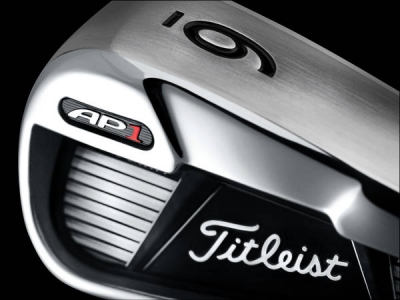 |
The AP irons (which stands for Advanced Performance) were precisely the ‘marriage’ that Titleist was looking for, according to Chris McGinley, the company’s Vice President, Golf Club Marketing. “Titleist’s new AP irons embody significant improvements in feel, forgiveness and shot control to what have already been recognized as technical, high performance iron design.”
He continues, “The new AP irons offers our most successful ‘marriage’ of playability and forgiveness, and traditional looks, feel and feedback. The concept for the original Advanced Performance irons arose as a result of research that indicated serious golfers want performance with great feel, not performance at the expense of feel.”
To further that end, the Titleist R&D team’s advanced research group conducted extensive sound and vibration analysis aimed at reducing the harsh lower frequency vibration that causes poor feel in irons. The research led to combining several technologies and materials in the back cavity of the new AP irons, resulting in a new Tuned Feel System to take feel to a new level.
For anyone who’s ever hit irons that literally ‘hurt’ your hands, you know exactly what McGinley is talking about in terms of reducing vibration to improve feel. Today’s highly engineered irons clearly reduce that type of annoyance, though it’s a constant struggle.
As far as the AP1 irons are concerned, McGinley says they’re first and foremost, more forgiving. He explains how: “A perimeter weighted back flange and tungsten nickel sole bar locates the Center of Gravity (CG) low and deep for increased Moment of Inertia (MOI), forgiveness and stability. The thinner face and revamped duel cavity design of the AP1 pushes weight to the perimeter for a hotter ball-flight – and the high-density tungsten nickel sole bar reduces low frequency vibration for a solid, livelier feel.”
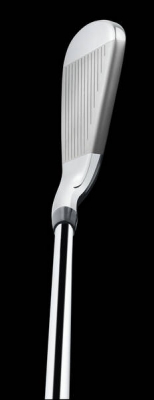 |
Player feedback contributed to the AP1’s design as well, as players asked for a more traditional profile, and the company responded by incorporating it into the design. The AP1 short irons now feature shorter blade lengths, thinner top-lines and reduced visual offset to deliver control and performance from within scoring range.
The new AP1 irons also incorporate a new high performance sole with width, camber and bounce specs designed to deliver playability from a variety of lies and turf conditions without excessive bounce or dig.
The AP1’s definitely offer a more traditional look than some other newer vintage game-improvement irons, but make no mistake, they’re still larger and ‘thicker’ in appearance than old-style blades. This is hardly a problem, but for those of us who’ve traditionally played the smaller, thinner profile clubs, it requires a period of visual adjustment.
Helping with the adjustment is the friendly playing qualities of the irons, which are as good as advertised. I found them to be very forgiving and confidence inspiring from all types of lies, but especially from the rough (which I probably visit more frequently than a good many folks).
According to McGinley, the ‘forgiveness’ is built-in with materials and improved weight distribution. “Historically, the goal has been to redistribute as much weight as possible to the outer edges of the clubhead (and usually lower in the sole, which helps to get the ball in the air). The more weight you can move, the higher the MOI you can achieve – and higher MOI is the key to forgiveness, producing shots of acceptable quality even on off-center hits.”
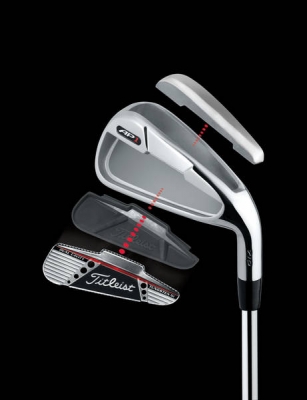 |
McGinley also said that higher MOI in the past came at the expense of greater feel. New materials have allowed the Titleist engineers to create an amazingly forgiving iron that also provides great feel and articulate feedback.
The AP1 iron utilizes several new materials to achieve its performance gains. Its construction features a precision-cast 431 stainless steel body and a high density tungsten nickel sole. “This heavy tungsten material lends great stability to the clubhead through impact and as it interacts with the turf and also works in concert with the new Tune Feel System to reduce low frequency vibration for solid feel. The new Tune Feel System consists of a co-molded medallion of soft elastomer and aluminum plate. This insert has been specifically designed to improve the sound and feel of each new iron,” McGinley explained.
Admittedly, it’s difficult for any golfer to ‘see’ the material benefits in advanced sets of golf clubs, though again, the proof’s in the results. The looks of the AP1 scream high-tech – not something you’d see Old Tom Morris carrying around the Old Course, but it’s a golf club that you’ll feel confident incorporates the latest that golf’s design-oriented minds can create these days.
As far as how you’ll know they’re right for you, McGinley says fitting is essential. “Irons have to be hit and fit. The shape and cosmetics of an iron should be considered – it’s important that an iron looks good to a player at address and inspires confidence – but how an iron performs and feels is the most important consideration.”
Titleist, like all top manufacturers, highly recommends a fitting session with a qualified club-fitter prior to purchase. “The shaft, lie angle, length and even grip size can have a dramatic effect on an iron’s performance,” McGinley added. “In a proper club fitting, different iron models can be tested and compared side by side on equal footing duplicating the specifications that are appropriate for that particular golfer. In our view, a proper fitting is the only way to make a sound choice when it comes to buying golf clubs, or golf balls, for that matter!”
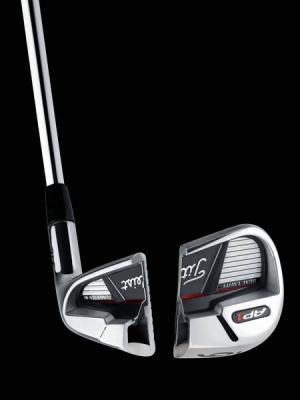 |
It’s nice to see the confidence in McGinley’s words – because if he’s willing to pit his products against those of the competition, you know you’re getting what you pay for.
As always, there’s a question of who the AP1’s are geared towards, and McGinley says they’ll appeal to average players as well as low-handicappers. “Average golfers will enjoy how easy the AP1 irons are to hit and how well these irons make the most out of shots that are struck less than perfectly. Better players will be amazed by the solid feel and responsiveness that they can receive in a forgiving, perimeter-weighted iron. All players will easily recognize the Titleist quality, consistency and performance that the new AP1 irons deliver.”
Part of the performance involves distance, which we noted was greater with the AP1 irons than with other models from other manufacturers. The set runs 4-iron through ‘w’ wedge (there is no three-iron in the set), but the distance on the individual irons was about 7-8 yards longer per iron. Added distance can be a good thing, but that too, requires adjustment.
McGinley said a three-iron is available, though the trend for many golfers these days is to replace their long irons with hybrids (and even a great many pros). As for the extra distance, “AP1 iron lofts are slightly stronger because the tungsten nickel sole creates a low center of gravity in the clubhead, considerably influencing a high launch and ball flight. Stronger lofts balance this effect, producing familiar trajectories for any given club,” McGinley lectured.
As far as the ‘w’ wedge, its loft of 50-degrees will serve as a gap or approach wedge for most players.
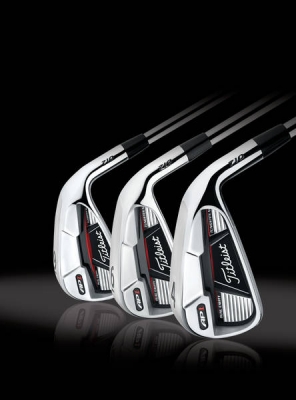 |
There’s no doubt that Titleist should feel proud of its AP1 irons product, but there are many, many good choices in the marketplace. Why is Titleist better? McGinley says their advantage is due to several factors. “Not taking into account Titleist’s tour-validated track record or the unparalleled customer support we provide, someone would choose a Titleist golf club because they’ve hit a Titleist golf club.”
He continues, “Our commitment to quality, innovation and state-of-the-art performance becomes evident to golfers in the ball flight that they experience when they hit a Titleist driver, fairway metal, hybrid, iron or wedge. There is no other reason to choose a club and no other consideration we ask of consumers.”
McGinley also rejects the notion that equipment manufacturers are pushing technology too far, arguing that it’s just the opposite – they’re making the game better.
“Technological advancements (in golf equipment, agronomy, instructional tools and player development) are an integral part of the game, its history and its appeal! At Titleist, we will always strive to make equipment that allows golfers to play better and to better enjoy the game. We pride ourselves on never introducing a new product to market unless it provides an appreciable improvement to the model that came before it. As we have demonstrated with the success of the new AP1 irons, we will continue to stay true to this standard and develop improvements and new products that benefit golfers and the game of golf,” McGinley added.
And judging by what Titleist’s accomplished with the AP1 irons, a blissful marriage of forgiveness and feel has already been consummated.
Details:
Titleist’s AP1 Irons
Available at higher-end golf retailers. Consult the Website for a dealer near you:
www.Titleist.com
Please visit Titleist\\\'s FittingWorks.com for more information on club fitting and to find a qualified club fitter:
http://www.fittingworks.com/Home.aspx
Please also visit Titleist.com\\\'s Golf Ball Fitting section for more information on choosing the right golf ball for your game:
http://www.titleist.com/golf-ball-fitting/
| Related Links | Comments on this article? | |
|
Maryland National Golf Club Hollow Creek Golf Club Rocky Gap Resort PB Dye Golf Club in Ijamsville Whiskey Creek Golf Club |
E-mail Jeff Rendall, Editor: jrendall@golftheunitedstates.com |











